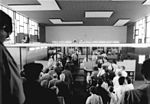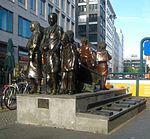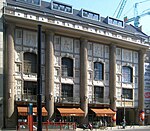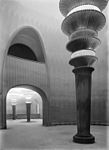Berlin Friedrichstraße station

Berlin Friedrichstraße (German: [bɛʁˌliːn ˈfʁiːdʁɪçˌʃtʁaːsə] (listen)) is a railway station in the German capital Berlin. It is located on the Friedrichstraße, a major north-south street in the Mitte district of Berlin, adjacent to the point where the street crosses the river Spree. Underneath the station is the U-Bahn station Friedrichstraße.Due to its central location in Berlin and its proximity to attractions such as the Unter den Linden boulevard, the Brandenburg Gate and the Reichstag, the station is a favorite destination for tourists. At the same time, it is the main junction for regional traffic in Berlin, measured by the number of passengers.During the Cold War, Friedrichstraße became famous for being a station that was located entirely in East Berlin, yet continued to be served by S-Bahn and U-Bahn trains from West Berlin as well as long distance trains from countries west of the Iron Curtain. The station also was a major border crossing between East and West Berlin.
Excerpt from the Wikipedia article Berlin Friedrichstraße station (License: CC BY-SA 3.0, Authors, Images).Berlin Friedrichstraße station
Georgenstraße, Berlin Mitte
Geographical coordinates (GPS) Address Nearby Places Show on map
Geographical coordinates (GPS)
| Latitude | Longitude |
|---|---|
| N 52.520277777778 ° | E 13.386944444444 ° |
Address
Georgenstraße 14-18
10117 Berlin, Mitte
Germany
Open on Google Maps











